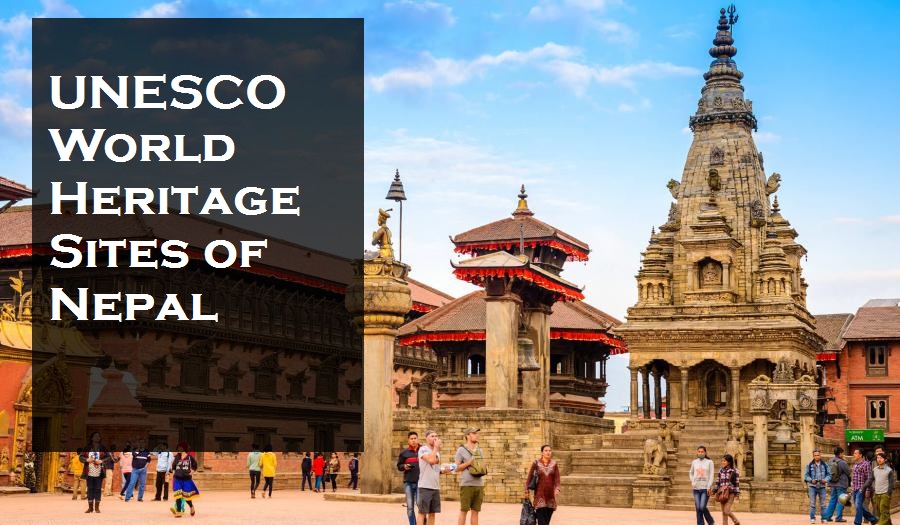
Be a part of an amazing experience; visit architecturally and culturally rich heritage sites in Kathmandu Valley and Lumbini, the birthplace of the Buddha. Enjoy the scenic wilderness amidst the spectacular flora and fauna of Nepal’s Himalaya in the Sagarmatha National Park or head for the serene Chitwan National Park for sightings of diverse wildlife. Whether you are a nature lover or a culture enthusiast, there’s something for everyone here.
UNESCO has listed 4 UNESCO World Heritage Sites of Nepal; Chitwan National Park and Sagarmatha National Park are listed as UNESCO Natural World Heritage Sites; Kathmandu Valley counted as one and Lumbini – the birthplace of Lord Buddha are listed as UNESCO Cultural World Heritage Sites.

UNESCO World Heritage Sites of Nepal | Cultural heritage of nepal
Kathmandu Valley
Known as one of the world’s oldest capitals, Kathmandu Valley has 7 UNESCO sites in the heritage list. These 7 sites boasts of cultural and historical monuments that represent various era and regimes.
The Pashupatinath Temple, one of the holiest places for Hindus, lies on the banks of the Bagmati River.
Swayambhunath Stupa, which is probably 2,500 years old is the oldest heritage of Kathmandu Valley on the UNESCO list. The Stupa has two eyes representing wisdom and compassion and 13 rings representing the 13 steps of ladder leading to Nirvana.
The 3 durbar squares of Kathmandu, Bhaktapur and Lalitpur were capitals of the three states of the valley (Kantipur, Bhadgaun and Patan respectively) during the Malla era. These durbar squares possess the unique architecture and tiered temples and intricate works of wood and metals.
Another UNESCO listed site is the Boudhanath Stupa. Built around 5th century the stupa is a mandala-style structure and is one of the biggest monument of Nepal. Boudhanath’s vicinity is full of cultural attractions.
Changu Narayan Temple and its Newari settlement is also included in the list. The temple was built in 3rd century BC and is located on a hilltop in Bhaktapur.

Lumbini Temple
Lumbini, the birthplace of Lord Buddha is located in the southern plains 300 km west of Kathmandu. Also called Shakyamuni Buddha, he was born in the sacred gardens of Lumbini in 623 BC, evidenced by the inscriptions seen on the Ashoka Pillar. Other notable sites around Lumbini are the Maya Devi Temple, World Peace Stupa, the eternal flame, etc.
Lumbini Temple About
Lumbini has a number of older temples, including the Mayadevi Temple, and various new temples, funded by Buddhist organisations from various countries, have been completed or are still under construction. Many monuments, monasteries and a museum, and the Lumbini International Research Institute are also within the holy site. Also, there is the Puskarini, or Holy Pond, where the Buddha’s mother took the ritual dip prior to his birth and where he had his first bath. At other sites near Lumbini, earlier Buddhas were, according to tradition, born, then achieved ultimate Enlightenment and finally relinquished their earthly forms.

Sagarmatha National Park
Sagarmatha National Park was listed as a UNESCO in 1979. A remarkable aspect of this national park is that it includes the world’s highest mountain – Everest and other famous peaks like Lhotse, Pumori, Cho Oyu, Nuptse and Ama Dablam. The national park is located at Solukhumbu District which has been inhabited by the Sherpas for the last four centuries.
Sagarmāthā National Park About
Sagarmāthā National Park is a national park in the Himalayas of eastern Nepal that is dominated by Mount Everest. It encompasses an area of 1,148 km2 (443 sq mi) in the Solukhumbu District and ranges in elevation from 2,845 to 8,848 m (9,334 to 29,029 ft) at the summit of Mount Everest. In the north, it shares the international border with Qomolangma National Nature Preserve of Tibet. In the east, it is adjacent to Makalu Barun National Park, and in the south it extends to Dudh Kosi river. It is part of the Sacred Himalayan Landscape.

Chitwan National Park
Established as the first national park of Nepal in 1973, Chitwan National Park was listed as a heritage site in 1984. The national park covers an area of 932 sq.km2 . Rich in biodiversity and ecosystems, Chitwan National Park is home to endangered mammals like the Bengal Tiger, One Horned Rhino, etc and has one of the largest Sal forests of the country. Chitwan is also the home of the indigenous Tharu community.
Chitwan National Park About
Chitwan National Park is the first national park in Nepal. It was established in 1973 and granted the status of a World Heritage Site in 1984. It covers an area of 952.63 km2 (367.81 sq mi) and is located in the subtropical Inner Terai lowlands of south-central Nepal in the districts of Nawalpur, Parsa, Chitwan and Makwanpur. In altitude it ranges from about 100 m (330 ft) in the river valleys to 815 m (2,674 ft) in the Churia Hills.
In the north and west of the protected area the Narayani-Rapti river system forms a natural boundary to human settlements. Adjacent to the east of Chitwan National Park is Parsa National Park, contiguous in the south is the Indian Tiger Reserve Valmiki National Park. The coherent protected area of 2,075 km2 (801 sq mi) represents the Tiger Conservation Unit (TCU) Chitwan-Parsa-Valmiki, which covers a 3,549 km2 (1,370 sq mi) huge block of alluvial grasslands and subtropical moist deciduous forests.
Author Profile
- I am the owner of the blog readree.com. My love for technology began at a young age, and I have been exploring every nook and cranny of it for the past eight years. In that time, I have learned an immense amount about the internet world, technology, Smartphones, Computers, Funny Tricks, and how to use the internet to solve common problems faced by people in their day-to-day lives. Through this blog, I aim to share all that I have learned with my readers so that they can benefit from it too. Connect with me : Sabinbaniya2002@gmail.com
Latest entries
 Digital MarketingJuly 13, 2025The Future of .NET Security: Key Trends to Watch in 2025
Digital MarketingJuly 13, 2025The Future of .NET Security: Key Trends to Watch in 2025 BlogJuly 12, 2025Top 10 AI Video Generator Tools to Watch in 2025
BlogJuly 12, 2025Top 10 AI Video Generator Tools to Watch in 2025 Artificial IntelligenceJuly 11, 2025Why AgentForce Is the Right Choice for Generative AI Development
Artificial IntelligenceJuly 11, 2025Why AgentForce Is the Right Choice for Generative AI Development Artificial IntelligenceJuly 10, 2025The Role of AI in Shaping Full-Stack Product Development in 2025
Artificial IntelligenceJuly 10, 2025The Role of AI in Shaping Full-Stack Product Development in 2025